Behaviour covers a wide spectrum from foraging and hunting methods to bird song and mating and breeding activity. I might add that the call or song of a bird is sometimes the only way of identifying a bird briefly glimpsed or unseen, particlularly in forest and woodland. As other sections cover some of these behaviours in detail, here we shall focus on a few helpful examples that are diagnostic in identifying "families" and "genus" (see speciation section). Some species' behaviour makes them conspicuous and easily observed while others are more secretive and harder to find.
I have also included some useful tips on how to make your bird watching successful.
Extroverts
Why are certain species easy to spot and other very elusive? It's often due to behaviour related to their habitat and methods of feeding.
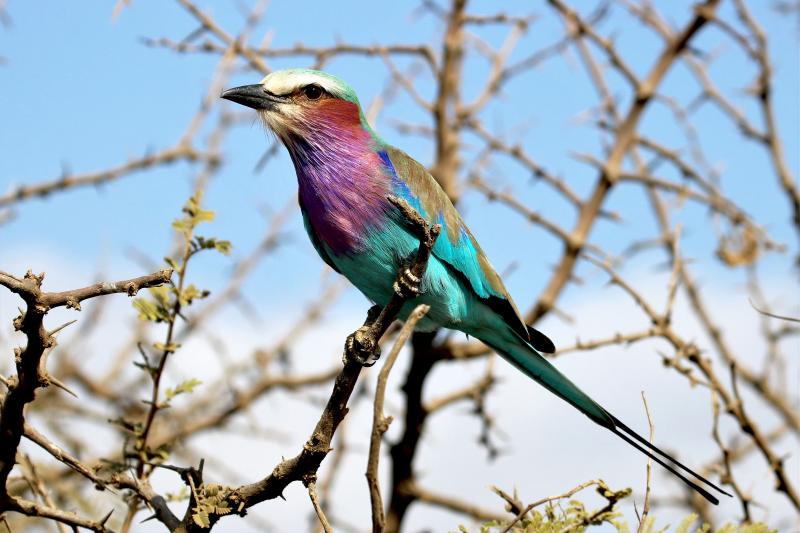
Lilac-breasted Roller
If you visit national parks in sub-Saharan Africa, such as Kruger, a bird you are bound to notice is the beautiful lilac-breasted roller. It is easily seen both because of its bright colours and its preference for conspicuous vantage points at the tops of trees in open woodland and savanna where it can spot its prey of scorpions, snails, lizards, insects, rodents and small birds on the ground. It must be one of the world's most photographed birds as it so visible and so much admired by visitors. Kruger National Park, South Africa where I photographed the roller above is one of the best places to view them.
Purple Roller
Other members of the roller family (Coraciidae), such as the purpler roller and the indian roller, are also highly visible. They are so named because of their aerobatic displays when courting or defending territory. The purple roller above was also photographed in Kruger National Park, South Africa.
If you can, see the world! Travel to known locations for good bird watching.
Bee-eaters adopt similar, prominent positions, such as posts, tree branches and telegraph wires which are convenient for aerial sorties after bees and other insects which they capture in flight, returning immediately to a vantage point ready for the next assault.
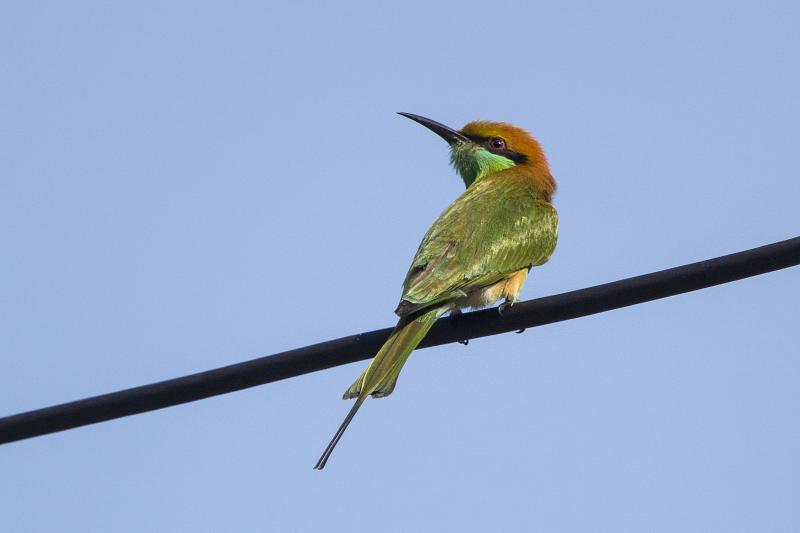
Green Bee-eater
This beautiful bird was photographed in Khao Lom Muak National Park, Thailand, where it was one of many feeding in the afternoon sunshine.
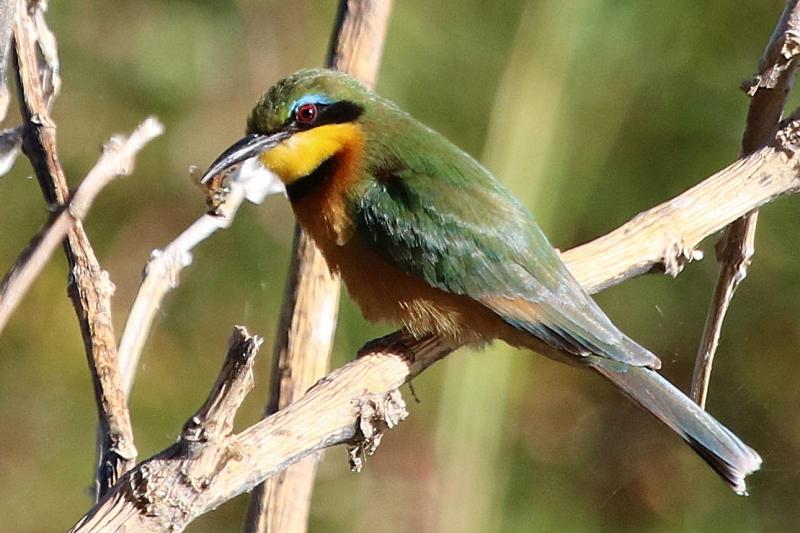
Little Bea-eater
Here is another member of the bee-eater family (Meropidae). This one, photographed on Msuna Island on the Zambezi River, Zimbabwe, lives up to its name having just taken a bee in mid air.
Introverts
At the other end of the spectrum are elusive birds whose sightings are highly prized by bird watchers. Even though it is classified as "Least Concern" by the IUCN (The International Union for the Conservation of Nature), I waited a long time to photograph an African finfooot, a secretive freshwater bird prefering to stay close to thick aquatic plants along the banks of slow moving rivers and lakes. I knew from my reading where to look so was always alert when I saw an appropriate habitat.
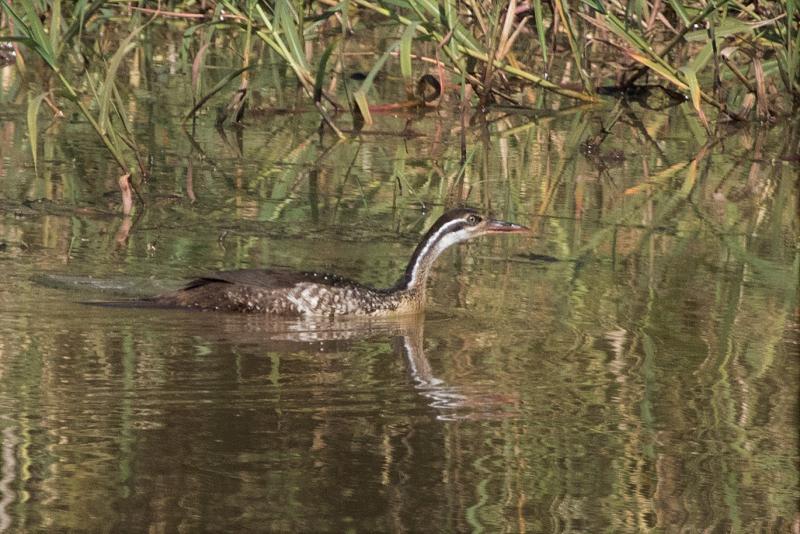
African Finfoot
The African finfoot belongs to a family of three (Heliornithidae) with two other equally secretive members, the Asian finfoot and the sungrebe, the latter found in tropical and sub-tropial America. I photographed the African variety above in Hluhluwe National Park, Kwa-Zulu Natal, South Africa.
Do your homework - know what you are looking for and where to look for it.
It is often difficut to find arboreal (tree dwelling) and terrestrial (ground dwelling) forest birds. You have to look up through dense foliage with the obstacle of bright sunlight and restricted view. At best, you may only see a sillouette, a partial glimpse. Alternatively, ground dwellers are very well hidden in undergrowth with the added handicap of poor light.
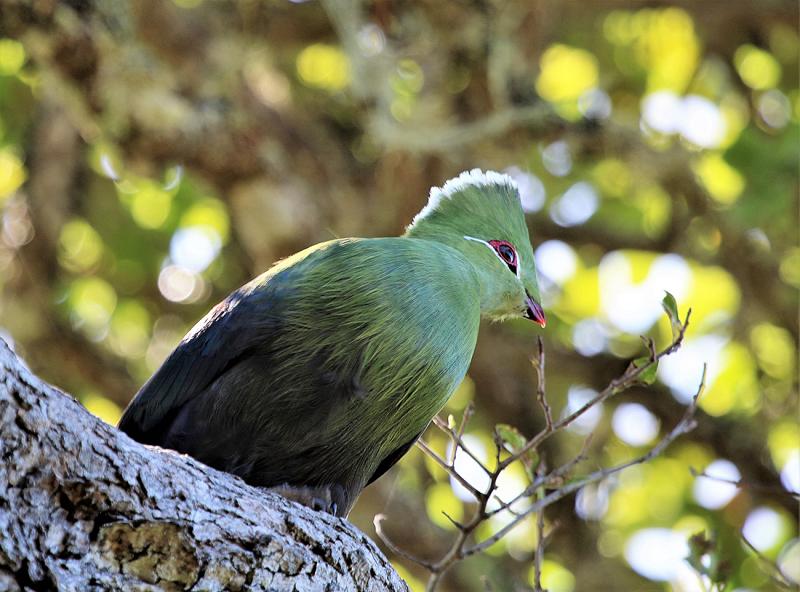
Knysna Lourie
Another elusive species, the Knysna lourie, prefers dense woodland and is usually only seen flying between trees. I was walking along a path through small, closely packed trees next to Groenvlei, a lake in Western Cape, South Africa when I heard the lourie in the photograph foraging in the branches above my head. It peered down at me very briefly and I was able to take this one reasonable picture with the light enhanced leaves as a backdrop.
Be prepared for that surprise sighting.
The lourie, or turaco family, (Musophagidae - translated from the Latin means banana eaters), contains several arboreal members including the purple crested lourie or turaco which can also be difficult to pinpoint in its natural habitat.
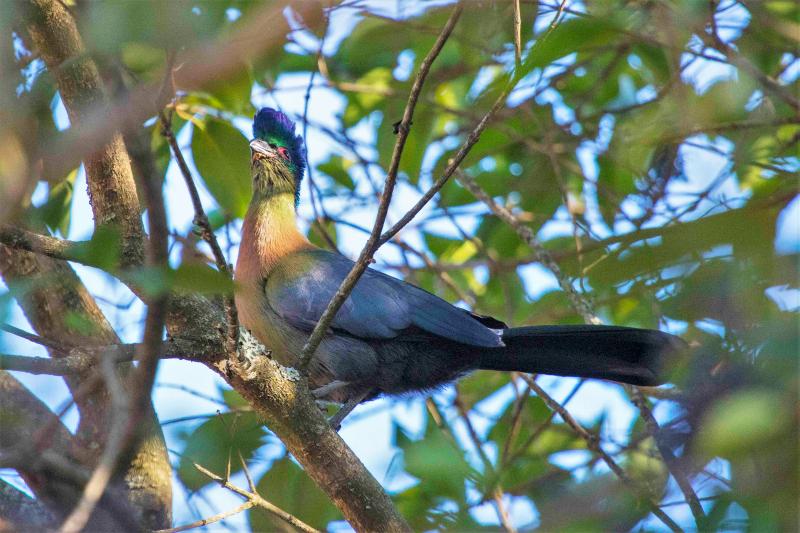
Purple-crested Lourie
I was trying to photograph a small flock of purple-crested lourie about an hour after dawn in the garden of a house where I was staying in Harare, Zimbabwe. Foliage and branches blocked my view and the birds were constantly on the move foraging for berries and fruit. This was my best photograph. The upper part of the bird is clear but the rump and tail are in shadow due to the strong light. Incidentally, the owner of the property where I saw this bird, was confident she knew every bird in her large garden. The picture of the purple-crested lourie came as a complete surprise to her. Like most birds, they feed very early in the morning when they are at their most visible and she was never in her garden at that time.
The best time to view birds is early morning and early evening - feeding time.
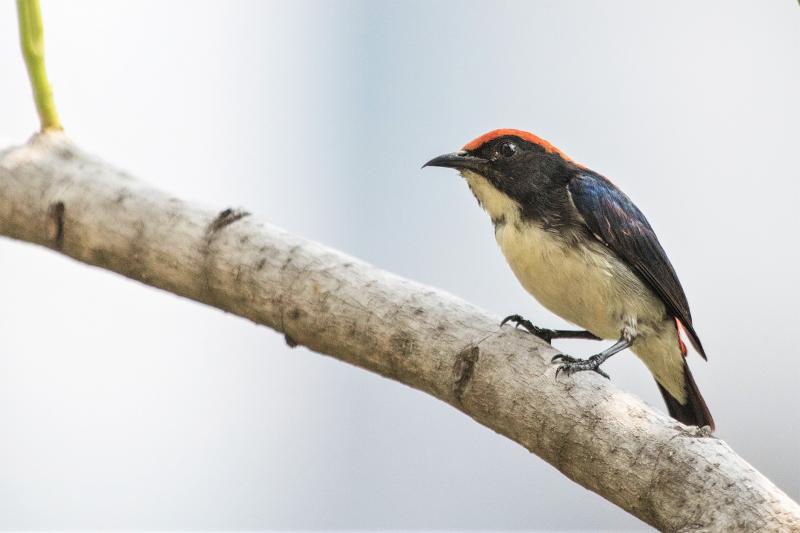
Scarlet-backed Flowerpecker
I was lucky to be able to view this tiny, arboreal scarlet-backed flowerpecker from the upper storey window of an apartment block in Bangkok. With a rather monotonous, rhythmic tweet, this bird is usually heard rather than seen, like many arboreal species. Both size and habitat make it a very difficult bird to observe.
Height is an advantage when watching arboreal species and never forget to consider what might be on your doorstep.
Waders can be easier to see but difficult to identify. You can always distinguish the plovers (Charadriinae) from the sandpipers (scolopacidae) by the formers' short beaks and the way they scuttle across the sand or mud to quicky prod the surface for their invertebrate meal.
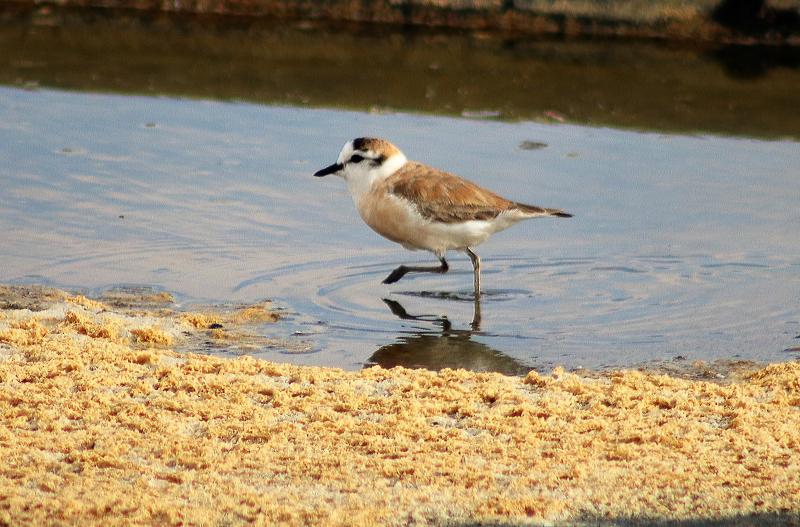
White-fronted Plover
Determined and on the move, this white-fronted plover at Walvis Bay, Namibia hunts for breakfast at low tide.

Common Sandpiper
In contrast sandpipers are slower and more deiiberate using their longer beaks to probe deep into the sand for their invertebrate diet. This common sandpiper is working the beach in the "uprush" (between the wave break and the high point up the beach reached by the water). Note the contrasting ways the plovers and the sandpipers have evolved in order to exploit different environmental niches.
The way birds move and feed are clues to identity.
Waders tend to feed in open habitats, in estuaries, in mudflats and on beaches. They are very visible, but that works both ways. Waders tend to want a substantial "flight initiation distance": they will fly away before you can get close enough for a good view. It's a survival technique that ensures they are not taken by predators. Nor do you really want to disturb them when they are feeding. Binoculars are a prerequisite (see equipment section).
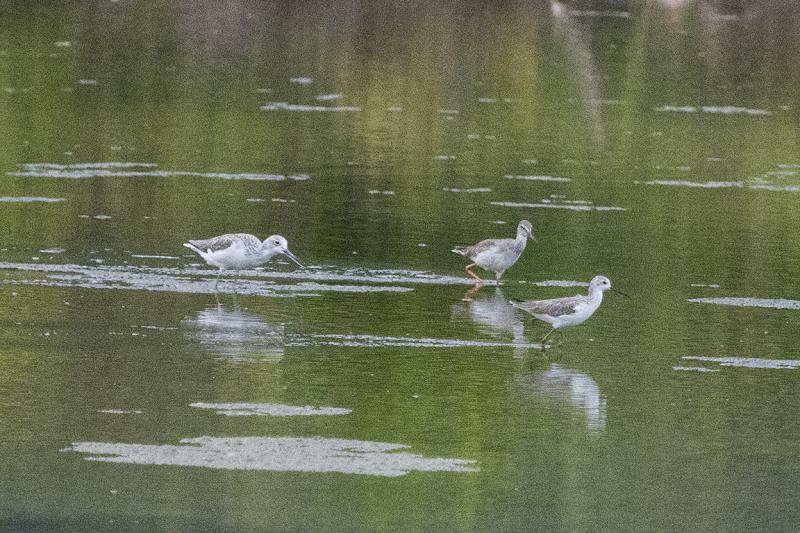
Greenshank, Common Red shank, Marsh Sandpiper
I had to crop severely to get the picture (see photography sub section). The subjects were just too far away. Nice composition, but the quality is poor. Such a pity because it could have been a great shot of 3 different species which I think I have identified correctly but it's difficult to be sure. I was on foot when I took the shot from a causeway leading into Khao Sam Roi Yot National Park, Thailand. Viewing from a hide can often be the best and only way of seeing some wildlife and waders often fit this category. Vehicles offer a similar advantage as both birds and animals that flee at the first sighting or scent of homo sapiens on foot seem unphased by homo sapiens safely ensconced in a car.
Your bird watching is likely to be more successful if you can view birds from a hide or a vehicle and you should always carry binoculars.
While we are on the subject of binoculars, I always go for small and compact enough to carry in its case attached to my belt. My "bins" are 10x25 with a 10x magnification and an aperture size of 25, which is relativly small and lets in less light, the price you pay for compact size. If you are not concerned about bulk and weight, 8 or 10 by 40 or 50 is recommended for bird watching. With greater magnification, it is difficult to keep a steady image.
Optimal Flight Distance
There is an interesting concept related to natural selection known as "Optimal Flight Distance". Yes, birds need to escape predators, but they also need to feed. If they are too nervous and fly away at the slightest sign of danger, their feeding is disrupted and they suffer physical consequences. If they fly too late, then they become victims of predation. The optimal flight distance is a compromise that has evolved as the most foolhardy birds are killed off by predators and the most skittish are weakened by hunger and at best are considered unsuitable by potential mates. Hence the genes of the birds who get it just right are the ones that are past on to future generations.
Optimal flight distance can be altered under certain conditions. We all know of species that adapt very quickly to the presence of humans and learn to live off them if not with them. Species that share a space with humans, such as parks, botanic gardens and the grounds of large resorts, are often more approachable than they would be in a habitat untainted by human contact. As a result they can provide excellent opportunities for legitimate bird watching "in the wild".

Stork-billed Kingfisher
I was able to get unusually close to this curious, stork-billed kingfisher perched next to a path by a lake in Singapore Botanic Gardens.
Visit parks and gardens for some easily accessible bird watching.
Then there are the birds that hunt at night or are at best "crepuscular". "Diurnal" (daytime) birds are relatively easy to observe by comparison with "nocturnal"( active at night) or crepuscular(active at dusk and dawn) birds. Most members of the owl family (Strigidae) fit into the nocturnal and crepuscular categories. They are particularly challenging for photographers who need good light (see photography sub section).
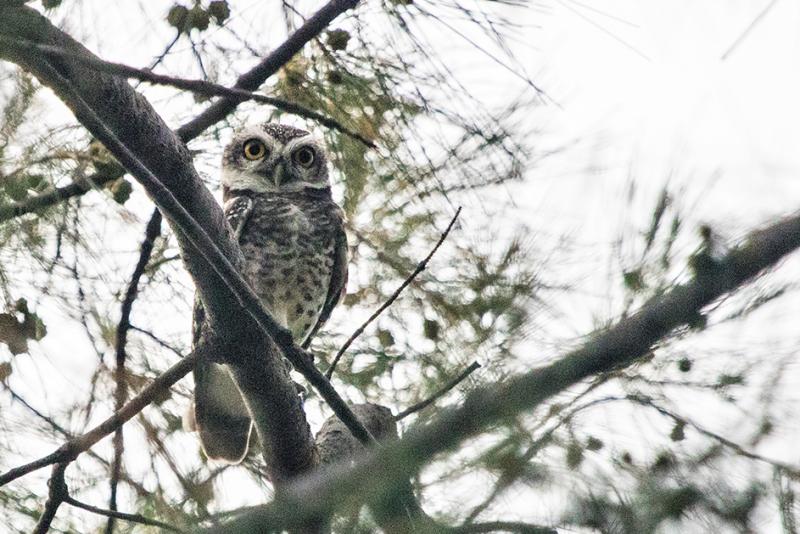
Spotted Owlet
I photograhed this spotted owlet flying between trees close to dusk in Khao Sam Roi Yot coastal national park in Thailand. I was able to find the tree it landed in and took a series of shots in poor light from different angles as branches obsured my view. As always, I was wearing grey and brown clothing that enabled me to blend with my surroundings and used trees and bushes for cover so I could get closer to the owl without disturbing it.
Owl Power
The inconvenience of bird watching in poor light is insignificant compared with the advantage owls gain from the reduced competition of hunting at night. They have evolved large eyes and binocular vision, silent flight ability and superb hearing to enable them to thrive in challenging conditions. Note also the subdued mottled browns that provide excellent camouflage.
Be patient, wear clothes with colors that blend, use cover where available and move slowly and silently.
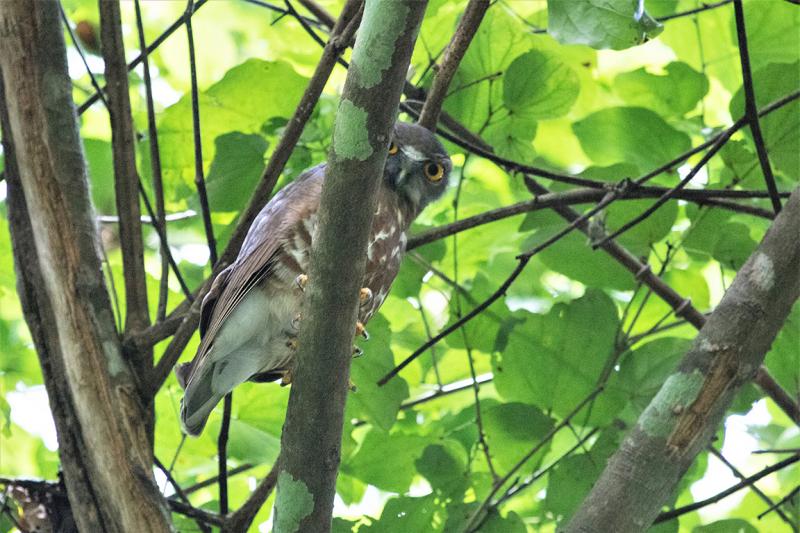
Brown Hawk Owl
I photographed this nocturnal hawk owl in its daytime roost at a nature resort in Phetchaburi Province, Thailand. It was difficult to see: the camera saw the bird far more clearly than I did. How did I find it? I didn't. I was led there by the proprietor, a keen naturalist who had lived in the extensive grounds of the resort for several years.
Use local knowledge and the expertise of your fellow enthusiasts. Join a bird watching group and share knowledge and information.
Bird Song
Bird calls and songs are an important way of identifying birds. Every species has its own unique call and the passerines, the so called song birds, can have songs of considerable complexity and they can have extensive repertoires. Familiarity with bird songs and calls can help you with identification as well as lead you to locations where you might actually get a sighting, although with forest species, you often have to be satisfied with the auditory experience. For a full account of the importance of bird calls and songs, refer to the Mating and Speciation chapters. For individual bird calls and songs refer to the bird profiles in the country index or specific bird species, use the subject index.
Learn as many bird songs and calls as you can to add an additional dimension to your interest in birds. Bird song identifies a species and can lead you to a sighting.
Migration
Some birds reside in the same location throughout their lives. Others move from place to place within a region. There are also birds that travel thousands of miles twice a year between their wintering grounds and their breeding sites. Knowing where a bird will be in a particular season is a great aid to identification. For more information on migration refer to the "Where and When" section of this chapter and the Speciation chapter ("Bird Brains - Skill Set").
Knowing which birds migrate enables bird watchers to know which species to look out for at different times of the year.
Tawny Eagle
Finally, if you can't get to the birds, bring the birds to you. A bird bath, seed dispenser, suet pellet, fat ball and fruit can work wonders attracting birds to your garden or balcony. Research what you need, place them in a cat free zone and await your guests.
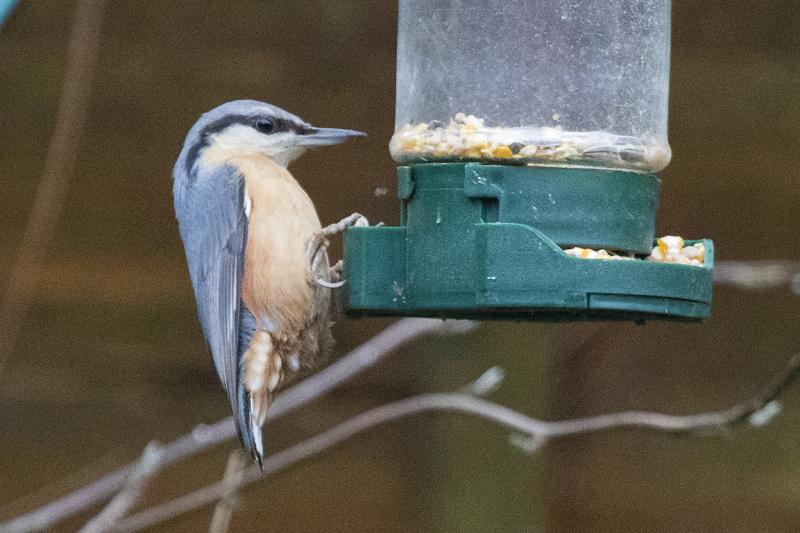
Eurasian Nuthatch
Photographed in a garden in Manchester, United Kingdon, this Eurasian Nuthatch feeds from a seed dispenser on a cold winter's day.
Provide food and water and enjoy bird watching from your own home